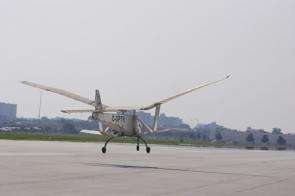University of Toronto ornithopter takes off

Professor Emeritus James DeLaurier achieved something in early July that has fascinated humankind throughout much of history. DeLaurier and a team of students at the University of Toronto Institute for Aerospace Studies achieved sustained flight by a piloted ornithopter – an airplane with flapping wings that are mechanically operated – something dreamed of by Leonardo da Vinci, among others.
“He though about it carefully,” said DeLaurier of da Vinci’s design for an ornithopter. “He put a remarkable amount of thought into it but was limited by the materials of his time.”
The concept of an ornithopter differs from standard fixed-wing aircraft because when flying its wings flap up and down in a manner similar to that of birds in flight. “It’s an ancient dream, achieving flight with flapping wings,” said DeLaurier, a professor of aerospace engineering at U of T since 1974, who retired this summer.
With the help of his current research team of four students, test pilot Jack Sanderson and a few other volunteers, DeLaurier achieved his lifelong dream of flying a full-scale ornithopter July 8 at Downsview Park. Equipped with a 24-horsepower engine and a model airplane turbo booster, the ornithopter flew for 14 seconds at an average speed of 88 km/h, in the process travelling a third of a kilometre.
“It was sustained flight; no one can question that. It received help from the booster jet but the majority of the thrust was from the flapping wings,” DeLaurier said. “When it did fly we were pretty happy. I was just hollering with joy.”
He said it also felt like a great burden of responsibility had been lifted from his shoulders. “I had committed myself to seeing this through but the project was always held together on a shoestring budget.”
The flight ended due to a stress-related failure in one section of the left wing. The ornithopter’s nose and front wheel were damaged during landing.
Project Ornithopter began in 1986 when DeLaurier was able to turn his hobby of building model-sized ornithopters into a research project housed at UTIAS. Though the project had many stops and restarts over the years, by 1995 it had produced the ornithopter that flew at Downsview Park.
Years of testing and debugging then followed and DeLaurier estimates that 50 to 60 students have worked on the ornithopter during the life of the project. “It’s a great educational experience for the students. They get the experience of working in a team and they also get the hands-on experience of working on an actual aircraft,” said DeLaurier, noting several graduate students have done thesis work on research topics related to ornithopter flight.
Jennifer Elliott, a third-year aerospace engineering student, said the project is a good combination of theory and practical application. “When we do all the theoretical work in the classroom, it shows me the practical results. We see how those calculations are used in real-world applications,” Elliott said.
Todd Reichert, completing his master’s degree in aerospace engineering, said there’s a lot of hard work involved in getting an aircraft to fly for the first time and the ornithopter project has been one of many challenges. “At the same time, it’s been an awesome experience. Aerospace is a lot of working with computers, so it’s exciting to be doing something where you’re actually out in the real world testing something you helped build,” Reichert said.
DeLaurier hopes to receive funding to repair the ornithopter and continue with the research project. In the meantime, the ornithopter is on display at the Toronto Aerospace Museum in Downsview Park.
Source: University of Toronto





















